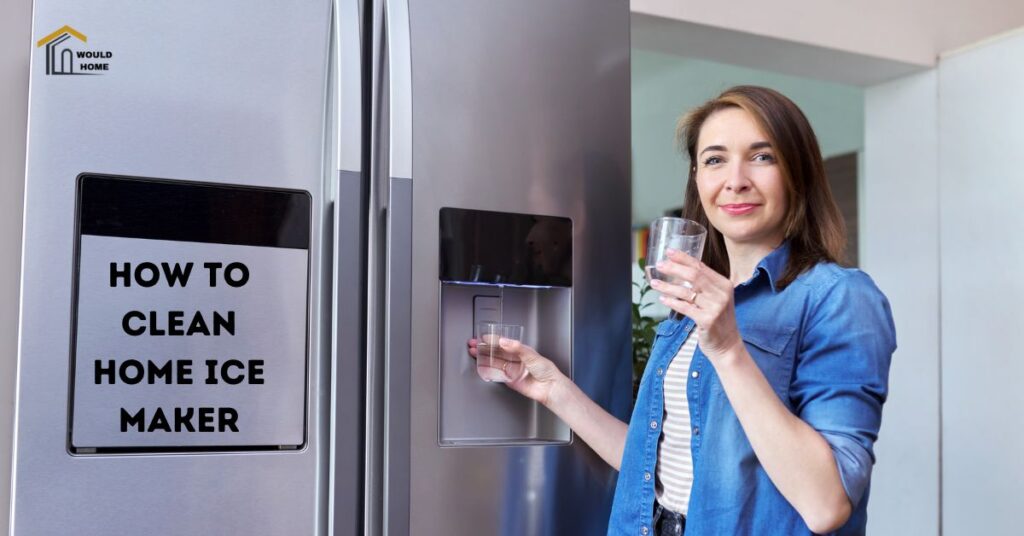Are you tired of cloudy and foul-tasting ice cubes? It’s time to give your private home ice maker a miles-wished deep smooth. With our clean-to-comply guide, you’ll learn how to clean your home ice maker and ensure your ice is sparkling and pure each time. Cleaning your ice maker is important for maintaining the quality of your ice cubes. Over time, minerals and contaminants can build up within the device, affecting the flavor and appearance of your ice. But fear no longer! Our step-by-step commands will help you eliminate residue and keep your ice maker in top-notch condition.
Table of Contents
Why It’s Important to Clean Your Home Ice Maker
A clean home ice maker is crucial for retaining the pleasant and pure ice it produces. Over time, minerals, mold, and bacteria can accumulate in the system, resulting in cloudy and foul-tasting ice cubes. Regular cleansing ensures that your ice is visually attractive and helps remove any potential health dangers.
When you forget to smooth your ice maker, the buildup of contaminants can affect the taste of your ice cubes. The presence of mildew or microorganisms can result in an ugly scent and an off-taste on your drinks. Additionally, minerals from difficult water can cause white flakes or particles to appear in the ice, compromising its visible enchantment.
Frequently cleansing your home ice maker can prevent these troubles and ensure clear ice cubes. Not only will your drinks taste better, but you can also have peace of mind knowing that your ice maker is free from dangerous substances.
Signs That Your Home Ice Maker Needs Cleaning
It’s essential to know the signs that indicate your home ice maker wants a thorough cleaning. If you note any of the subsequent, it is time to roll up your sleeves and get to work:
Cloudy or discolored ice cubes: If your ice cubes are not crystal clear and appear cloudy or have a bizarre shade, it indicates that your ice maker needs cleansing. A buildup of minerals or contaminants typically causes cloudiness.
Foul smell or bizarre flavor: If your ice cubes have an unsightly scent or taste, it signals that your ice maker harbors mildew or bacteria. It can appear if the system has not been cleaned often or is uncovered to unsanitary conditions.
Slow ice manufacturing: If your ice maker produces ice slower than usual, it may be due to a clogged or dirty gadget. When minerals or particles accumulate within the device, they could impede the ice-making technique, resulting in slower ice manufacturing.
Ice cubes with debris or flakes: If you notice white particles or flakes in your ice cubes, it’s possibly due to minerals from hard water. These particles can affect the taste and appearance of your ice and indicate that your ice maker needs cleansing.
If you revel in these symptoms, it is time to give your home ice maker an intensive cleaning to restore its performance and ensure that your ice cubes are smooth and clean.
Step-by-Step Guide on How to Clean Home Ice Maker
Cleaning your private home ice maker might also appear frightening, but with our step-by-step manual, it is a breeze. Follow those simple commands to acquire a glowing, easy ice maker:
Unplug the ice maker: Unplug your ice maker from the electricity supply before you begin cleansing. This step is essential for your safety and stops any unintentional damage to the gadget.
Empty the ice bin: Take out and throw away any ice cubes that may have been inside. If the ice cubes appear discolored or have an ugly smell, your ice maker needs cleaning.
Remove and clean detachable elements: Most home ice makers have removable parts that must be cleaned separately. Check the user guide for precise commands to eliminate these parts. Common detachable parts encompass the ice bin, ice scoop, and water reservoir.
Prepare a cleansing solution: Mix warm water and mild dish soap in a clean bucket or sink. The ratio should be about one tablespoon of dish-cleaning soap to a gallon of water. Stir the solution until the cleaning soap is dissolved.
Clean detachable parts: Submerge the removable elements in the cleaning solution and scrub them gently with a gentle brush or sponge. Pay close attention to any regions where residue or buildup has been seen. Rinse the parts thoroughly with clean water and pat them dry with an easy towel.
Clean the indoors: Dip a smooth fabric or sponge into the cleansing answer and wipe the interior of the ice maker. Be positive to attain all corners and surfaces, paying greater interest to areas wherein mold or residue may be a gift. Rinse the cloth or sponge regularly and continue until the indoors is thoroughly easy.
Clean the ice-making mechanism: Use a gentle brush or toothbrush to smooth the ice-making mechanism inside the ice maker. Gently scrub any residue or buildup, not damaging any delicate components. Rinse the mechanism with warm water to remove any cleaning soap residue.
Rinse and sanitize: Once all indoor components are smooth, rinse them thoroughly with smooth water to remove any cleaning soap residue. To sanitize the ice maker, prepare a solution of one teaspoon of bleach in step with a gallon of water.
Dip a clean fabric or sponge into the solution and wipe the interior and removable parts. Allow the bleach solution to sit briefly, then rinse everything thoroughly with smooth water.
Dry and reassemble: After rinsing, dry all of the ice maker’s components and interior with a smooth towel. Ensure that everything is completely dry to prevent mildew or bacteria growth. Once dry, reassemble the ice maker, ensuring each component is securely in place.
Following those step-by-step instructions, you can attain a smooth and well-maintained home ice maker that produces crystal-clean ice cubes on every occasion.
Recommended Cleaning Products for Home Ice Makers
When cleaning your home ice maker, you don’t need to put money into costly or specialized cleaning merchandise. Most of the important cleaning may be finished using simple household ingredients. Here are a few endorsed cleansing merchandise for domestic ice makers:
Mild dish cleaning soap: A moderate dish soap cleans your ice maker’s interior, detachable elements, and ice-making mechanism. Look for a mild method that doesn’t comprise harsh chemical compounds.
White vinegar: White vinegar is an herbal cleansing agent that can help remove mineral deposits and buildup from your ice maker. It is particularly powerful for descaling your ice maker if you have hard water.
Bleach: Bleach is an effective sanitizer that efficiently kills mold and microorganisms. However, it should be used cautiously and in the advocated dilution ratios to avoid harm to your ice maker or other health risks.
Soft brush or toothbrush: A smooth-bristled brush or toothbrush is ideal for scrubbing residue and buildup from detachable parts and the ice-making mechanism. Make sure the brush is smooth and free of any residual cleaning products.
Remember to study the manufacturer’s instructions and pointers before using cleansing products on your ice maker. Some manufacturers might also have specific recommendations or restrictions regarding cleansing dealers to ensure the machine’s sturdiness and performance.
Tips for Maintaining a Clean Home Ice Maker
Cleaning your property ice maker is just step one towards preserving its cleanliness and overall performance. By following these guidelines, you can ensure that your ice maker stays smooth and produces awesome ice cubes:
Regular cleaning schedule: Set an ordinary cleaning schedule for your ice maker to save any minerals, mildew, or bacteria buildup. Depending on your usage and water first-class, cleansing your ice maker every three to six months is usually recommended.
Use filtered water: If you have hard water or water with an excessive mineral content, it’s advisable to use filtered water for your ice maker. It reduces the amount of mineral buildup and ensures that your ice cubes are clear and flavour-unfastened.
Empty and clean the ice bin regularly: Empty the ice bin often to prevent any lingering odors or go-contamination. Remove any last ice cubes, discard them, and wipe the ice bin easily with a mild dish soap answer. Rinse thoroughly and dry before setting it lower back within the ice maker.
Keep the ice maker dry: After cleaning and before your ice maker earlier, ensure the interior is completely dry. Excess moisture can sell the boom of mildew or bacteria, compromising the cleanliness of your ice maker.
Store ice cubes in a separate box: If you do not use all the ice cubes at once, transfer them to a separate container and save them in the freezer. It prevents any capacity infection from different food objects within the freezer and keeps your ice cubes sparkling and clean.
By incorporating those guidelines into your ice maker maintenance recurring, you could enjoy easy and clean ice cubes all 12 months round.
Common Mistakes to Avoid When Cleaning Your Home Ice Maker
While cleaning your property ice maker is pretty simple, you must avoid a few common mistakes to ensure the surest effects. By being privy to these errors, you can maintain the cleanliness and overall performance of your ice maker:
Harsh chemical compounds or abrasive cleaners can damage your ice maker’s interior and sensitive components as your primary cleaning agents stick to moderate dish soap, white vinegar, and bleach (in endorsed dilutions).
Neglecting easily removable parts: Removable parts, including the ice bin and water reservoir, should be wiped separately to ensure thorough cleansing. Neglecting those elements too easily can cause go-contamination or the buildup of residue.
Failing to rinse very well: After cleansing, it is vital to rinse all elements and the indoors of your ice maker very well. Any ultimate cleansing solution or residue can affect the taste and first-rate of your ice cubes.
Not drying the ice maker properly: Moisture is the enemy of an easy ice maker. Failing to dry all elements and the interior thoroughly can lead to the growth of mold or bacteria. Take the time to ensure that the whole lot is absolutely dry before reassembling your ice maker.
Overlooking the ice-making mechanism: The ice-making mechanism is regularly forgotten while cleansing an ice maker. However, it could harbor residue or buildup that affects the fine of your ice cubes. Make sure to ease this region thoroughly with a tender brush or toothbrush.
By warding off these not-unusual errors, you can successfully ease your house ice maker and maintain its cleanliness and performance for years.
Troubleshooting Common Issues with Home Ice Makers
While normal cleansing can prevent most troubles with domestic ice makers, occasional problems may also arise. Here are a few not-unusual problems and troubleshooting guidelines:
Slow ice manufacturing: If your ice maker generates ice slower than usual, it can be because of a clogged water line or a dirty clear-out. Check the water line for obstructions and easily update the filter if necessary.
Small or misshapen ice cubes: If your ice cubes are smaller than regular or have an abnormal form, it can be a sign of low water strain or a malfunctioning water inlet valve. Check the water stress and ensure the water inlet valve is functioning nicely.
Conclusion | How to clean home ice maker
Maintaining a clean domestic ice maker ensures your ice cube’s quality and purity. Regular cleaning complements the flavor and appearance of your ice and prevents the buildup of contaminants that may affect your fitness. Following our step-by-step manual on how to clean your home ice maker, using simple family ingredients, and preventing unusual errors, you may achieve a glowing, clean ice maker that produces crystal-clear ice cubes each time. Remember to establish a normal cleaning schedule, use filtered water, and store ice cubes properly to hold the cleanliness and performance of your ice maker for years to come.



